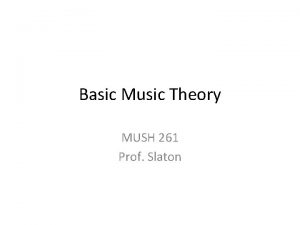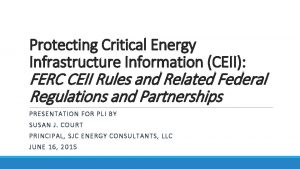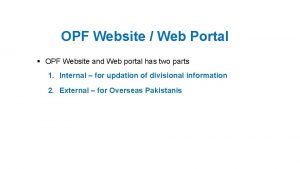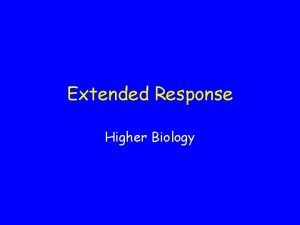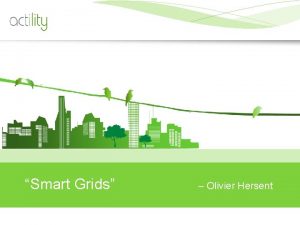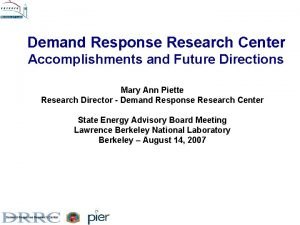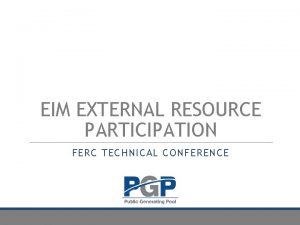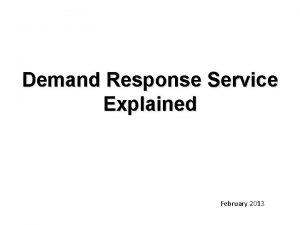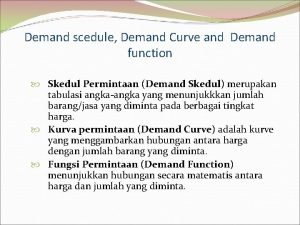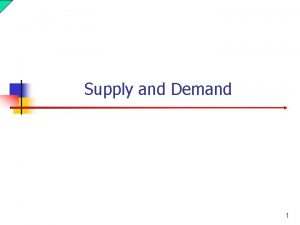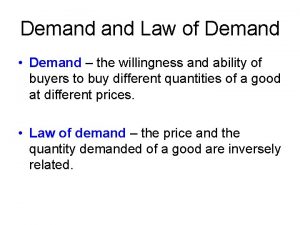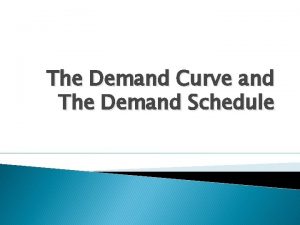FERC Staffs Report on Demand Response and Advanced


















- Slides: 18

FERC Staff’s Report on Demand Response and Advanced Metering

Michael Lee, Energy Analyst FERC

The Federal Energy Regulatory Commission’s Assessment of Demand Response & Advanced Metering Staff Report December 2014 NARUC Winter Committee Meetings: Electricity Staff and Electric Reliability Staff Subcommittees February 15, 2015 , Washington, D. C. by Michael P. Lee Office of Energy Policy and Innovation Federal Energy Regulatory Commission 3

The opinions and views expressed in this staff presentation do not necessarily represent those of the Federal Energy Regulatory Commission, its Chairman, or individual Commissioners, and are not binding on the Commission. 4

Assessment of Demand Response & Advanced Metering Staff Report, December 2014 n Today’s presentation will discuss: q Background on FERC’s Annual Assessments n n n q Purpose Approach Data Sources Highlights from 2014 Assessment 5

Assessment of Demand Response & Advanced Metering Staff Report, December 2014 n The Energy Policy Act of 2005 requires that FERC prepare and publish an annual report, by appropriate region, that assesses demand response resources, including those available from all consumer classes, and which identifies and reviews – q q 1) Saturation and penetration rate of advanced meters and communications technologies, devices and systems; 2) Existing demand response programs and time-based rate programs; 3) The annual resource contribution of demand resources; 4) The potential for demand response as a quantifiable, reliable resource for regional planning purposes; 6

Assessment of Demand Response & Advanced Metering Staff Report, December 2014 n The Energy Policy Act of 2005 requires that FERC prepare and publish an annual report, by appropriate region, that assesses demand response resources, including those available from all consumer classes, and which identifies and reviews (cont’d) – q q 5) Steps taken to ensure that, in regional transmission planning and operations, demand resources are provided equitable treatment as a quantifiable, reliable resource relative to the resource obligations of any load-serving entity, transmission provider, or transmitting party; and 6) Regulatory barriers to improved customer participation in demand response, peak reduction and critical period pricing programs. 7

Assessment of Demand Response & Advanced Metering Staff Report, December 2014 RTO & ISO Demand Response Programs n Eastern RTO-ISO system operators utilized demand response during Winter 2013/14 extreme weather events to balance the electric system and prevent reserve shortages. 8

Assessment of Demand Response & Advanced Metering Staff Report, December 2014 RTO & ISO Demand Response Programs n Potential peak reduction from RTO and ISO demand response programs increased by 9. 3 percent or 2, 452 MW between 2012 and 2013, to reach a total potential peak reduction of 28, 798 MW in 2013. n The potential peak reduction from customers participating in RTO and ISO programs also increased as a percentage of total peak demand, increasing from 5. 6 percent of peak demand in 2012 to 6. 1 percent in 2013. Potential peak reduction (or potential peak demand savings) refers to “the total demand savings that could occur at the time of the system peak hour assuming all demand response is called. ” U. S. EIA, Form EIA-861 Instructions, Schedule 6, Part B. 9

Assessment of Demand Response & Advanced Metering Staff Report, December 2014 Potential Peak Reduction from U. S. ISO/RTO Demand Response Programs 2012 RTO/ISO Potential Peak Reduction (MW) 2013 Percent of Peak Demand 8 Potential Peak Reduction (MW) Percent of Peak Demand 8 California ISO (CAISO) 2, 430 1 5. 2% 2, 180 9 4. 8% Electric Reliability Council of Texas (ERCOT) 1, 800 2 2. 7% 1, 950 10 2. 9% ISO New England, Inc. (ISO-NE) 2, 769 3 10. 7% 2, 100 11 7. 7% Midcontinent Independent System Operator (MISO) 7, 197 4 7. 3% 9, 797 12 10. 2% New York Independent System Operator (NYISO) 1, 925 5 5. 9% 1, 307 13 3. 8% PJM Interconnection, LLC (PJM) 8, 781 6 5. 7% 9, 901 14 6. 3% Southwest Power Pool, Inc. (SPP) 1, 444 7 3. 1% 1, 563 15 3. 5% Total ISO/RTO 26, 346 5. 6% 28, 798 6. 1% Source: FERC, Assessment of Demand Response & Advanced Metering Staff Report, (December 2014), Table 3 -3 (citing referenced data) 10

Assessment of Demand Response & Advanced Metering Staff Report, December 2014 Retail Demand Response Programs by NERC Region n According to data collected by EIA, total U. S. potential peak reduction from retail demand response programs increased by 1, 907 MW between 2011 and 2012 (7. 2 percent). n Demand response programs within the Western Electricity Coordinating Council (WECC) accounted for 1, 253 MW of potential peak reduction or nearly two-thirds (65. 7 percent) of the total increase in the U. S. between 2011 and 2012. Potential peak reduction (or potential peak demand savings) refers to “the total demand savings that could occur at the time of the system peak hour assuming all demand response is called. ” U. S. EIA, Form EIA-861 Instructions, Schedule 6, Part B. 11

Assessment of Demand Response & Advanced Metering Staff Report, December 2014 Potential Peak Reduction from Retail DR Programs by NERC Region AK FRCC HI MRO NPCC RFC SERC SPP TRE WECC Unspecified Total Annual Potential Peak Reduction (MW) 2011 2012 28 3, 360 43 5, 450 613 5, 529 5, 937 1, 215 340 4, 016 63 26, 596 27 3, 306 42 5, 567 606 5, 836 6, 046 1, 323 480 5, 269 0 28, 503 Year-on-Year Change MW % -1 -54 -1 117 -7 307 109 108 140 1, 253 -63 1, 907 -3. 6% -1. 6% -2. 1% -1. 2% 5. 6% 1. 8% 8. 9% 41. 3% 31. 2% -100. 0% 7. 2% Source: U. S. EIA, EIA-861 file 3_2011, dsm_2012 and utility_data_2012 data files. Note: Although some entities may operate in more than one NERC Region, EIA data have only one NERC region designation per entity. Commission staff has not independently verified the accuracy of EIA data. 12

Assessment of Demand Response & Advanced Metering Staff Report, December 2014 n Advanced Metering The penetration of advanced meters continues to climb as utilities’ continue their respective electric grid modernization efforts. n According to the EIA, an additional 5. 9 million advanced meters were installed and operational between 2011 and 2012, resulting in advanced meters representing almost 30 percent of all meters in the United States. n DOE’s Smart Grid Investment Grant (SGIG) program: as of March 31, 2014, approximately 15. 3 out of the 15. 5 million advanced meters were installed and made operational. 13

Assessment of Demand Response & Advanced Metering Staff Report, December 2014 Advanced Metering n Advanced metering infrastructure facilitates several beneficial applications which can lead to improvements in operational efficiency, reliability and asset utilization. The applications include: q Outage detection and notification q Voltage monitoring q Enabling integration of distributed energy systems through net metering q Enabling the application of time-based rates 14

Assessment of Demand Response & Advanced Metering Staff Report, December 2014 Advanced Metering (cont’d) n Some of the benefits achieved through advanced metering, customer systems, and time-based rates include: q Reduced electricity generation and environmental impacts q Expanded options for customers to manage electricity consumption and costs 15

Assessment of Demand Response & Advanced Metering Staff Report, December 2014 Regulatory Barriers n The 2014 Demand Response & Advanced Metering report describe the barriers to customer participation to demand response, and details actions and progress: q Lack of Uniform Standards for Communicating Demand Response Pricing, Signals and Usage Information q Lack of Support for Enabling Technologies q Opportunities for Customer Education and Engagement q Implementing Time-based Pricing 16

Demand Response Information Sources at FERC n Demand Response & Advanced Metering Webpage: Reports and datasets q n http: //www. ferc. gov/industries/electric/indus-act/demandresponse/dem-res-adv-metering. asp National Assessment & Action Plan on Demand Response (National Assessment, National Action Plan, Implementation Proposal) q http: //www. ferc. gov/industries/electric/indus-act/demandresponse/dr-potential. asp 17

Thank you. Michael P. Lee Federal Energy Regulatory Commission 888 First Street, NE Washington, DC 20426 (202) 502 -6548 Michael. Lee 2@ferc. gov 18
 The bass and treble staffs connected by a brace
The bass and treble staffs connected by a brace Ceii ferc
Ceii ferc Opf portal
Opf portal Vivian chum chum
Vivian chum chum Module 5 supply and demand introduction and demand
Module 5 supply and demand introduction and demand Natural and forced response
Natural and forced response Natural response and forced response example
Natural response and forced response example A subsequent
A subsequent Measures to correct excess demand and deficient demand
Measures to correct excess demand and deficient demand Dependent demand examples
Dependent demand examples Ang grapikong paglalarawan ng schedule ng demand
Ang grapikong paglalarawan ng schedule ng demand Methods of demand estimation in managerial economics
Methods of demand estimation in managerial economics Distinguish between individual demand and market demand
Distinguish between individual demand and market demand Dependent and independent demand in inventory management
Dependent and independent demand in inventory management Higher biology extended response
Higher biology extended response Demand response in smart grids
Demand response in smart grids Cpower demand response
Cpower demand response Demand response research center
Demand response research center Deterministic demand vs stochastic demand
Deterministic demand vs stochastic demand
